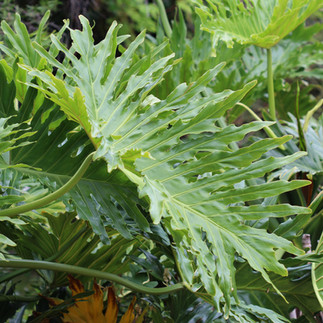Philodendrons 101
- Chantel

- Dec 15, 2023
- 3 min read
Philodendrons are a type of tropical plant that is native to warm climates. Around here, they are a very popular houseplant and there are many varieties of philodendrons to choose from, each one unique. Today we will be going over just a few of the hundreds of varieties and how to care for them.

Care
Philodendrons are fairly simple to care for!
They want to be watered when the soil dries out. Get a feel for what your plant weighs when it is freshly watered and when it is dry. This is an easy trick to tell if your plant needs water - just water it when it feels light! I also recommend a moisture meter, because even if the top of the soil is dry, the bottom of the pot may not be, and a mositure meter will tell you how wet the soil is deep where the roots are.
Light requirements for philodendron are generally bright indirect light (for a breakdown on light requirements, check out our other blog post here!). They can handle a bit lower light conditions, but they may become leggy or grow smaller leaves if there is too little.
Propagation

Philodendrons are also easy to propagate. They have nodes between their leaves that will shoot out roots.
When these nodes are put in water or soil, the roots will grow more, and turn into its own plant! The look and location of the nodes can vary depending on the type of philodendron you have, but in general, they will be between the leaves along the stalks.

You can use rooting powder to encourage root growth once you cut the node off the mother plant. This is a natural hormone that will quicken the root's growth.
Varieties
There are hundreds of varieties of philodendron! I am going to highlight some that we have or have had in stock at Green Valley, as well as some popular and unique ones! Can you collect them all?
Trailing
Trailing philodendrons are best on a higher shelf or in a hanging pot so that they can drape down easilly. This will provide the best visual interest, as well as give the plant lots of room to grow! You can also string them along a trellis to have them grow upward.
Hover above each of these photos to see the name of the variety.
Upright
An upright philodendron I classify as one with a stem that grown straight up from the pot and has leaves growing off of that stem. They can climb up a moss pole or similar trellis as well, but they are not the kind to trail over in a hanging basket like the ones above. Make sure these have light sources from all sides of it, or that you are rotating it around so that it doesn't grow sideways, toward the light.
Hover above each of these varieites to see what it is called!
Monstera vs Philodendrons
There is some confusion regarding the popular split leaf philodendron. There are many plants that have been called this name, all looking and growing differently. Oftentimes, they are even labelled incorrectly by nurseries! Hopefully I will be able to explain the difference here!
Monstera Deliciosa
A monstera deliciosa is oftentimes referred to as a split leaf philodendron, but is not a philodendron at all! Its common name is the swiss cheese plant. It is named for the holes, or fenestrations, in the leaves. It also is very good at vining, so in the wild, you would see them climbing up trees. This is very popular houseplant, and is used in interior design quite a bit.
Split Leaf Philodendron
A true split leaf philodendron is the philodendron bipinnatifidum. These look different in leaf shape than the swiss cheese plant. They have no fenestrations in the leaves, and are dramatically lobed leaves instead. They also don't vine. Sometimes, they can start to move up a tree in the wild, but they are not true vining plants. This leads them to have another nickname, the tree philodendron.
Monstera Adansonii
This plant is also often referred to as the swiss cheese plant, although some people use the term swill cheese vine, different than the swiss cheese plant, which I think would help relieve some confusion. This plant has smaller leaves than the swiss cheese plant, and has those signature fenestrations in the leaves. They will vine up a trellis or moss pole easilly, and is often sold that way in nurseries.

Mini Monstera
The mini monstera's botanical name is Rhaphidophora tetrasperma. It is different than a monstera, but given its similar leaf shape, it has gotten this nickname. This is a climbing plant, so it will often be sold on a moss pole or trellis.

I hope this clears up any confusion about the difference between the split leaf philodendrons you hear about!
If you have questions about your philodendrons, feel free to ask us! We love to talk plants with you!
Keep going and keep growing! Chantel













































Comments